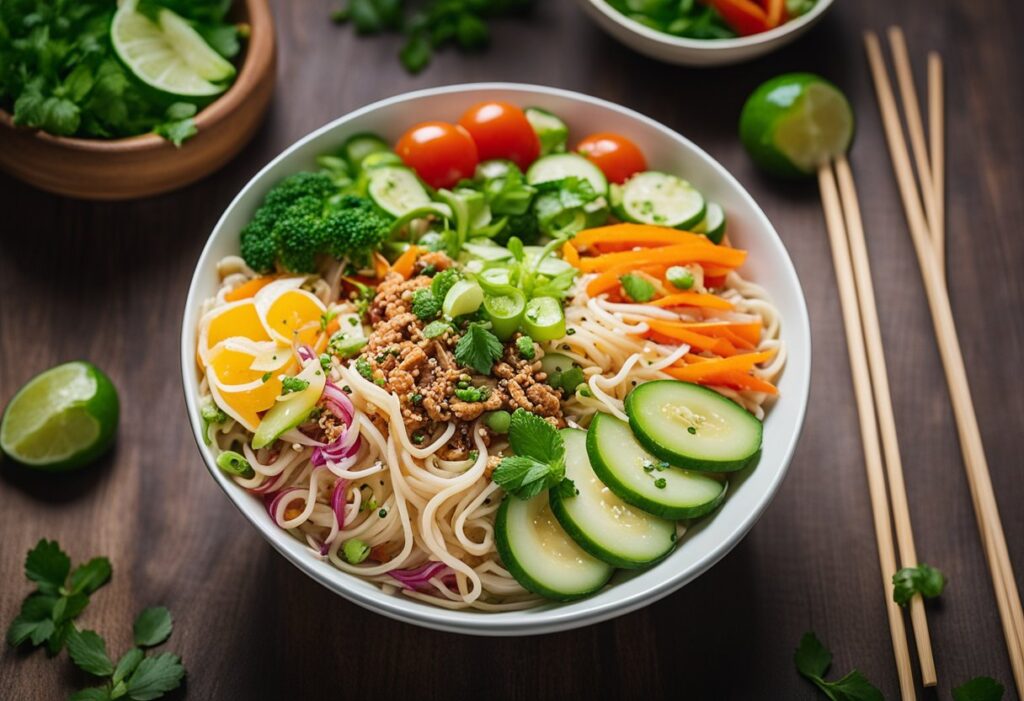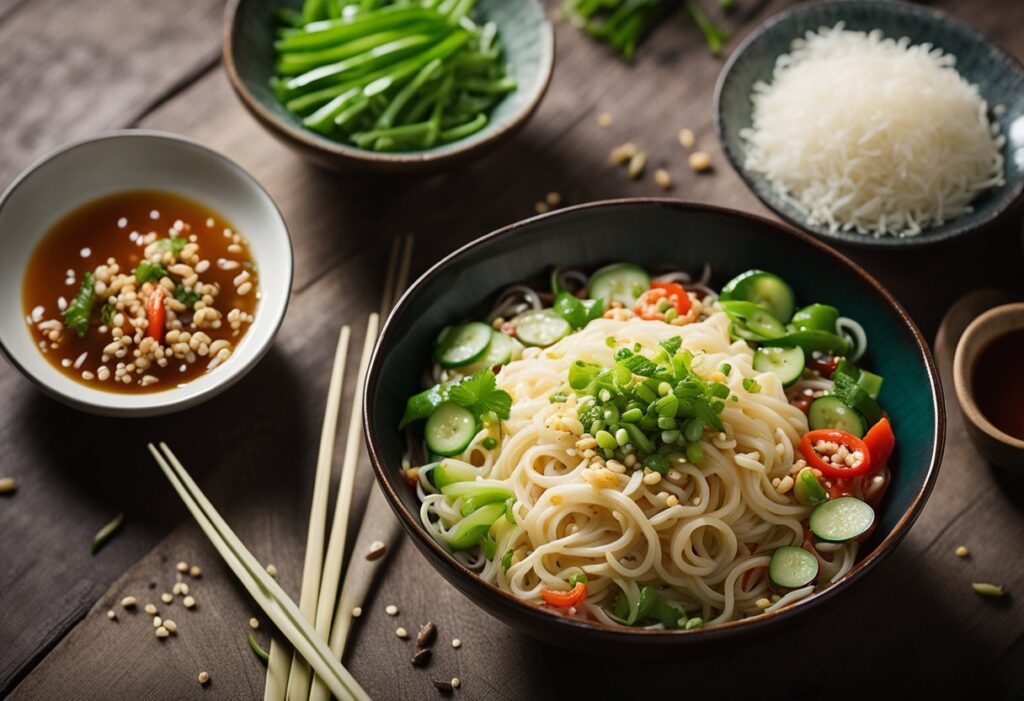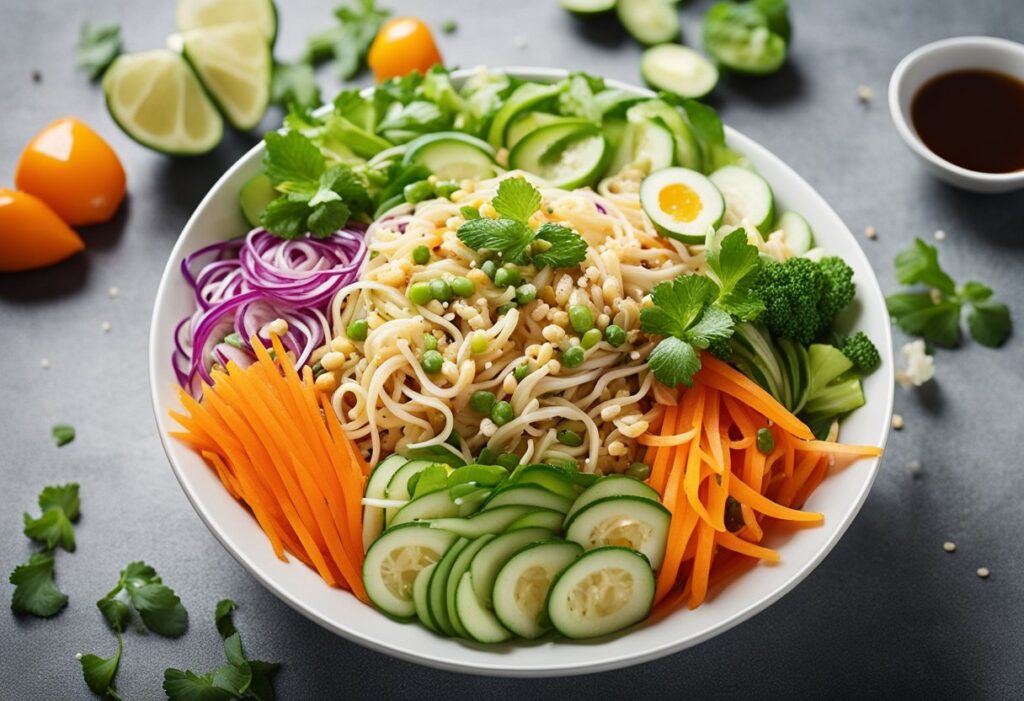Cold Asian noodle salad is a refreshing and flavorful dish that is perfect for warm weather. This dish is a popular choice in many Asian countries, including Japan, Korea, and China. It is typically made with thin noodles, fresh vegetables, and a tangy dressing that is both sweet and savory.
Table of Contents

One of the great things about cold Asian noodle salad is that it is incredibly versatile. You can use a variety of different vegetables, such as cucumber, bell peppers, and carrots, to add crunch and flavor. Some recipes also call for the addition of protein, such as chicken or tofu, to make it a more filling meal.
Overall, cold Asian noodle salad is a healthy and delicious option that is easy to make and perfect for any occasion. Whether you are looking for a light lunch or a tasty side dish for your next barbecue, this dish is sure to impress.
History of Cold Asian Noodle Salad

Cold Asian noodle salad is a popular dish that originated in East Asia. The dish is typically made with thin, wheat-based noodles, such as soba or somen, and is served cold with a variety of vegetables and a flavorful dressing.
The origins of cold Asian noodle salad can be traced back to Japan, where it is known as “hiyashi chuka.” It is believed that the dish was first introduced in the 1930s as a refreshing and light meal to be eaten during the hot summer months.
Over time, the dish has evolved and become popular in other East Asian countries, such as China and Korea, where it is known by different names. In China, it is called “liangpi” and is made with wheat or rice noodles and a spicy sauce. In Korea, it is known as “naengmyeon” and is made with buckwheat noodles and a cold beef broth.
Today, cold Asian noodle salad is enjoyed around the world and has become a staple in many Asian restaurants and households. It is a versatile dish that can be customized to suit individual tastes and preferences, and is often served as a light and healthy meal option.
Cultural Significance
Asian noodle salads have been a staple dish in many Asian countries for centuries. These salads are known for their unique blend of flavors and textures, which are achieved by combining a variety of ingredients such as noodles, vegetables, herbs, and spices.
In Japan, cold noodle salads are commonly served during the hot summer months as a refreshing and light meal. Soba noodles, made from buckwheat flour, are often used as the base for these salads. The noodles are typically served with a dipping sauce made from soy sauce, mirin, and dashi, a type of fish stock. The sauce is then mixed with the noodles and topped with various vegetables such as cucumber and scallions.
In China, cold noodle salads are often served as a side dish or appetizer. The noodles used in these salads are typically made from wheat flour or rice flour. The noodles are then mixed with a variety of ingredients such as shredded chicken, pork, or vegetables. The salad is then dressed with a mixture of soy sauce, vinegar, sesame oil, and sugar.
In Korea, cold noodle salads are known as naengmyeon. These salads are made with thin, chewy noodles made from buckwheat or sweet potato starch. The noodles are then served in a cold broth made from beef or dongchimi, a type of radish water kimchi. The salad is then topped with various ingredients such as sliced pear, cucumber, and boiled egg.
Overall, cold Asian noodle salads are a popular dish in many Asian countries due to their refreshing taste and versatility. They can be served as a main dish or as a side dish, and can be customized with a variety of ingredients to suit individual tastes.
Types of Cold Asian Noodle Salads

Soba Noodle Salad
Soba noodles are made from buckwheat flour and have a nutty flavor. They are a popular choice for cold noodle salads in Japan. Soba noodle salads often feature a variety of vegetables, such as cucumber, carrot, and scallions, and are dressed with a soy sauce-based dressing. Some variations may also include proteins like sliced chicken or shrimp.
Sesame Noodle Salad
Sesame noodle salad is a popular dish in Chinese cuisine. The noodles are typically made from wheat flour and are flavored with a sesame oil-based dressing. The salad is often garnished with sesame seeds and scallions. Other ingredients, such as sliced cucumber or shredded carrots, may also be added for additional texture and flavor.
Vietnamese Noodle Salad
Vietnamese noodle salad, also known as bun cha, is a refreshing and healthy dish. The salad is made with rice vermicelli noodles and is typically served with grilled meat, such as pork or chicken. The noodles are topped with a variety of fresh vegetables, including lettuce, cucumber, and bean sprouts. The dish is often dressed with a sweet and tangy fish sauce-based dressing.
Thai Noodle Salad
Thai noodle salad, or yum woon sen, is a popular dish in Thailand. The salad is made with glass noodles, which are made from mung bean starch and have a transparent appearance. The noodles are often mixed with a variety of vegetables, such as tomatoes, onions, and cilantro. The dish is typically dressed with a spicy and sour dressing made from lime juice, fish sauce, and chili peppers.
Overall, cold Asian noodle salads are a refreshing and healthy option for a summer meal. The different types of noodle salads offer a variety of flavors and textures, making them a versatile dish that can be customized to suit individual tastes.
Key Ingredients

Noodles
The foundation of any cold Asian noodle salad is, of course, the noodles. Thin, long noodles are preferred for their ability to hold onto the dressing and other ingredients. Popular options include soba noodles made from buckwheat flour, rice noodles, and glass noodles made from mung bean starch. These noodles are readily available in most grocery stores and Asian markets.
Vegetables
A variety of fresh vegetables are essential for adding color, texture, and flavor to the salad. Some popular options include thinly sliced cucumbers, carrots, bell peppers, and radishes. Bean sprouts and shredded lettuce can also be used to add a refreshing crunch. To save time, pre-cut vegetables can be used, but for the best flavor and texture, it is recommended to cut the vegetables fresh.
Proteins
Adding a source of protein to the salad makes it more filling and satisfying. Grilled chicken, shrimp, or tofu are popular options. Thinly sliced beef or pork can also be used. For a vegetarian or vegan option, tempeh or edamame can be added for a protein boost.
Dressings
The dressing is what ties all the ingredients together and gives the salad its signature flavor. A simple dressing of soy sauce, rice vinegar, sesame oil, and honey can be whisked together in a bowl. Other popular dressings include peanut sauce, miso dressing, or a spicy chili oil. It is important to adjust the seasoning to personal taste preferences and to avoid over-dressing the salad.
Preparation Techniques
Noodle Cooking
To prepare the cold Asian noodle salad, it is important to cook the noodles properly. The noodles should be cooked according to the package instructions until they are al dente. Once cooked, the noodles should be rinsed under cold water to stop the cooking process and prevent them from becoming mushy. After rinsing, the noodles should be drained well and tossed with a small amount of oil to prevent them from sticking together.
Vegetable Cutting
The vegetables used in the salad should be cut into small, bite-sized pieces. This will ensure that the salad is easy to eat and that each bite contains a mix of flavors and textures. The vegetables can be cut into thin strips, small cubes, or even grated, depending on personal preference. It is important to ensure that the vegetables are evenly cut to ensure even cooking and flavor distribution.
Dressing Mixing
The dressing for the cold Asian noodle salad should be mixed together in a separate bowl before adding it to the salad. This allows the flavors to meld together and ensures that the dressing is evenly distributed throughout the salad. The dressing can be a simple mix of soy sauce, rice vinegar, sesame oil, and honey, or it can be more complex with the addition of ginger, garlic, or chili flakes. It is important to taste the dressing and adjust the seasoning as needed before adding it to the salad.
By following these preparation techniques, you can create a delicious and flavorful cold Asian noodle salad that will impress your guests.
Serving Suggestions
This cold Asian noodle salad is a versatile dish that can be served as a main course or a side dish. Here are a few suggestions on how to serve it:
- As a main course: This salad can be a filling and satisfying meal on its own. Serve it with a side of steamed vegetables or a piece of grilled chicken or fish for a complete and balanced meal.
- As a side dish: This salad can also be a refreshing and light side dish to complement a heavier main course. It pairs well with grilled meats, seafood, or tofu.
- As a potluck dish: This salad is a great option to bring to a potluck or picnic. It can be made ahead of time and served cold, making it easy to transport and serve.
- As a meal prep option: This salad is also a great option for meal prep. Make a big batch at the beginning of the week and portion it out for easy and healthy lunches throughout the week.
To add some extra flavor and texture to the salad, consider topping it with some chopped peanuts, sesame seeds, or crispy fried onions. A drizzle of soy sauce or hoisin sauce can also add a savory and umami-rich flavor.
Nutritional Information
When it comes to cold Asian noodle salad, the nutritional value can vary depending on the ingredients used. Generally, cold Asian noodle salad is a healthy dish that provides a good source of protein, fiber, and essential vitamins and minerals.
One of the main ingredients in cold Asian noodle salad is noodles. Noodles are typically made from wheat or rice, and they provide a good source of carbohydrates. However, it’s important to note that noodles can be high in calories and carbohydrates, so portion control is key.
Another important ingredient in cold Asian noodle salad is vegetables. Vegetables such as carrots, cucumbers, and bell peppers are low in calories and high in fiber, vitamins, and minerals. These vegetables also provide a good source of antioxidants, which can help protect the body from damage caused by free radicals.
Protein is another important component of cold Asian noodle salad. Protein can come from a variety of sources such as tofu, chicken, or shrimp. These protein sources provide essential amino acids that are necessary for building and repairing muscle tissue.
Overall, cold Asian noodle salad can be a healthy and nutritious dish when made with the right ingredients. It’s important to pay attention to portion sizes and choose ingredients that are low in calories and high in nutrients.
Common Variations
Vegetarian and Vegan Options
For those who prefer a plant-based diet, cold Asian noodle salad can still be a delicious and satisfying meal. Instead of using meat or seafood, tofu or tempeh can be added to the salad for a protein boost. Vegetables such as bell peppers, carrots, and cucumbers can also be added for extra flavor and crunch. To make the dressing vegan-friendly, use a combination of soy sauce, rice vinegar, sesame oil, and maple syrup instead of honey.
Spicy Versions
For those who enjoy a bit of heat, adding chili oil or sriracha sauce to the dressing can give the salad a spicy kick. Sliced jalapenos or red pepper flakes can also be added for extra heat. To balance out the spiciness, adding a bit of sweetness to the dressing can help. A small amount of honey or brown sugar can be added to the dressing to balance out the heat.
Peanut-Free Alternatives
For those with peanut allergies, peanut butter can be substituted for almond butter or sunflower seed butter in the dressing recipe. If desired, chopped cashews or almonds can be added to the salad for a nutty flavor and crunch. Alternatively, sesame seeds can be used as a topping instead of peanuts.
Overall, cold Asian noodle salad is a versatile dish that can be easily adapted to suit different dietary preferences and tastes. Experimenting with different ingredients and dressings can lead to endless variations of this delicious and refreshing meal.
Pairings and Accompaniments
To make a complete meal out of the cold Asian noodle salad, there are a variety of pairings and accompaniments that can be added to enhance the flavors and textures. Here are a few suggestions:
Protein
Adding a protein source to the salad can make it more filling and satisfying. Grilled chicken, shrimp, or tofu are all great options. Simply season the protein with salt, pepper, and any other desired spices, and cook until fully cooked through.
Vegetables
To add more crunch and color to the salad, consider adding some fresh vegetables. Sliced cucumbers, shredded carrots, and chopped bell peppers all work well. You can also add some leafy greens, such as spinach or arugula, for some extra nutrition.
Dressing
While the dressing for the cold Asian noodle salad is already flavorful, you can always add more dressing or a different type of dressing to suit your taste preferences. A sesame ginger dressing or a spicy peanut sauce would both complement the flavors of the salad nicely.
Side Dish
If you’re looking for a side dish to serve alongside the cold Asian noodle salad, consider some steamed edamame or a vegetable stir-fry. These dishes will add some variety to the meal while still keeping with the Asian-inspired theme.
Storage and Leftovers
When it comes to storing cold Asian noodle salad, it is important to keep it refrigerated in an airtight container. This will prevent the salad from drying out and keep it fresh for longer. Leftovers can be enjoyed for up to 2-3 days after preparation.
To ensure the best possible taste and texture, it is recommended to keep the dressing separate from the salad until ready to serve. This will prevent the noodles from becoming soggy and the vegetables from losing their crunch.
If you find that the salad has become dry after being refrigerated, you can add a small amount of dressing or a splash of water to help revive the flavors and textures.
Overall, with proper storage and handling, cold Asian noodle salad can be enjoyed as a delicious and refreshing meal or side dish for several days.

